
James Riddle Hoffa was an American labor union leader who served as the president of the International Brotherhood of Teamsters (IBT) from 1957 until 1971.

The Cold Six Thousand is a 2001 crime fiction novel by James Ellroy. It is the first sequel to American Tabloid in the Underworld USA Trilogy and continues many of the earlier novel's characters and plotlines. Specifically, it follows three rogue American law-enforcement officials and their involvement in the turmoil of the 1960s. James Ellroy dedicated The Cold Six Thousand "To BILL STONER."

Santo Trafficante Jr. was among the most powerful Mafia bosses in the United States. He headed the Trafficante crime family from 1954 to 1987 and controlled organized criminal operations in Florida and Cuba, which had previously been consolidated from several rival gangs by his father, Santo Trafficante Sr.

Farrell Dobbs was an American Trotskyist, trade unionist, politician, and historian.
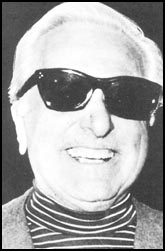
John"Handsome Johnny"Roselli, sometimes spelled Rosselli, was a mobster for the Chicago Outfit who helped that organization exert influence over Hollywood and the Las Vegas Strip. Roselli was recruited by the Central Intelligence Agency (CIA) in a plot to assassinate Cuban leader Fidel Castro.
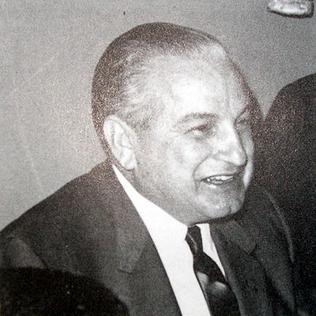
Carlos Joseph Marcello ;[Mor-sel-lo] born Calogero Minacore ; February 6, 1910 – March 3, 1993) was an Italian-American crime boss of the New Orleans crime family from 1947 to 1983.
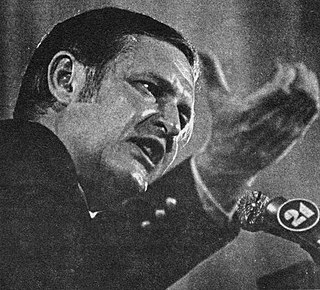
Jack Northman Anderson was an American newspaper columnist, syndicated by United Features Syndicate, considered one of the founders of modern investigative journalism. Anderson won the 1972 Pulitzer Prize for National Reporting for his investigation on secret U.S. policy decision-making between the United States and Pakistan during the Indo-Pakistani War of 1971. In addition to his newspaper career, Anderson also had a national radio show on the Mutual Broadcasting System, acted as Washington bureau chief of Parade magazine, and was a commentator on ABC-TV's Good Morning America for nine years.

William Guy Banister was an employee of the Federal Bureau of Investigation (FBI), an assistant superintendent of the New Orleans Police Department, and a private investigator. After his death, New Orleans district attorney Jim Garrison alleged that he had been involved in the assassination of John F. Kennedy.
The Underworld USA Trilogy is the collective name given to three novels by American crime author James Ellroy: American Tabloid (1995), The Cold Six Thousand (2001), and Blood's a Rover (2009).

Salvatore Mooney Giancana was an American mobster who was boss of the Chicago Outfit from 1957 to 1966.
Frank Ragano was a self-styled "mob lawyer" from Florida, who made his name representing organized crime figures such as Santo Trafficante, Jr. and Carlos Marcello, and also served as lawyer for Teamsters leader Jimmy Hoffa. In his 1994 autobiography Mob Lawyer, Ragano recounted his career in defending members of organized crime, and made the controversial allegation that Florida mob boss Santo Trafficante, Jr. confessed to him shortly before he died in 1987 that he and Carlos Marcello had arranged for the assassination of President John F. Kennedy in 1963.
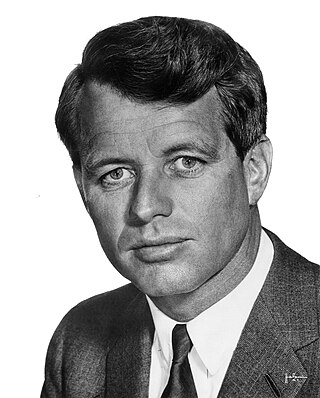
Robert Francis Kennedy, also known by his initials RFK and by the nickname Bobby, was an American politician and lawyer. He served as the 64th United States attorney general from January 1961 to September 1964, and as a U.S. senator from New York from January 1965 until his assassination in June 1968, when he was running for the Democratic presidential nomination. Like his brothers John F. Kennedy and Ted Kennedy, he was a prominent member of the Democratic Party and is an icon of modern American liberalism.
The Trafficante crime family, also known as the Tampa Mafia, is an Italian-American Mafia crime family based in Tampa, Florida. The most notable boss was Santo Trafficante, Jr. who ruled Tampa and the crime family with an iron fist. Author Scott Deitche reported that Santo Jr. was involved with the CIA to plot assassination attempts on Fidel Castro. After the death of Santo Jr. in 1987, the Tampa Mafia family has been controlled by Vincent LoScalzo.
The United States Senate Select Committee on Improper Activities in Labor and Management was a select committee created by the United States Senate on January 30, 1957 and dissolved on March 31, 1960. The select committee was directed to study the extent of criminal or other improper practices in the field of labor-management relations or in groups of employees or employers, and to recommend changes in the laws of the United States that would provide protection against such practices or activities. It conducted 253 active investigations, served 8,000 subpoenas for witnesses and documents, held 270 days of hearings, took testimony from 1,526 witnesses, and compiled almost 150,000 pages of testimony. At the peak of its activity in 1958, 104 persons worked for the committee. The select committee's work led directly to the enactment of the Labor-Management Reporting and Disclosure Act on September 14, 1959.
The CIA Kennedy assassination is a prominent John F. Kennedy assassination conspiracy theory. According to ABC News, the Central Intelligence Agency (CIA) is represented in nearly every theory that involves American conspirators. The secretive nature of the CIA, and the conjecture surrounding the high-profile political assassinations in the United States during the 1960s, has made the CIA a plausible suspect for some who believe in a conspiracy. Conspiracy theorists have ascribed various motives for CIA involvement in the assassination of President Kennedy, including Kennedy's firing of CIA director Allen Dulles, Kennedy's refusal to provide air support to the Bay of Pigs invasion, Kennedy's plan to cut the agency's budget by 20 percent, and the belief that the president was weak on communism.

Allen Melnick Dorfman was an American insurance agency owner and a consultant to the International Brotherhood of Teamsters (IBT) Central States Pension Fund. He was a close associate of longtime IBT President Jimmy Hoffa and associated with organized crime via the Chicago Outfit. Dorfman was convicted on several felony counts and was murdered in 1983.
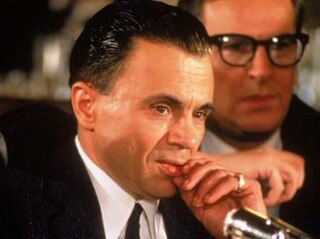
Blood Feud is a 1983 American two-part, four-hour made-for-television crime drama film centering on the conflict between Jimmy Hoffa and Robert F. Kennedy in an 11-year span from 1957 until Kennedy's assassination in 1968. The 210-minute film was directed by Mike Newell and written by Robert Boris. It stars Robert Blake as Hoffa and Cotter Smith as Kennedy with Danny Aiello and Brian Dennehy in supporting roles as union associates of Hoffa's.

The assassination of President John F. Kennedy on November 22, 1963 has spawned numerous conspiracy theories. These theories allege the involvement of the CIA, the Mafia, Vice President Lyndon B. Johnson, Cuban Prime Minister Fidel Castro, the KGB, or some combination of these individuals and entities. Some conspiracy theories have alleged a coverup by parts of the federal government, such as the original FBI investigators, the Warren Commission, or the CIA. Former Los Angeles District Attorney Vincent Bugliosi estimated that a total of 42 groups, 82 assassins, and 214 people had been accused at one time or another in various conspiracy scenarios.

James Neff is an American nonfiction author and investigative journalist. He is deputy managing editor for the Philadelphia Media Network. His most recent work, Vendetta: Bobby Kennedy versus Jimmy Hoffa, was published by Little, Brown and Company in July 2015.
William Eugene Bufalino was an American attorney who represented the International Brotherhood of Teamsters (IBT) from 1947 until 1971. He retired in 1982. Bufalino worked closely with Jimmy Hoffa until 1971. Bufalino died on May 12, 1990.














